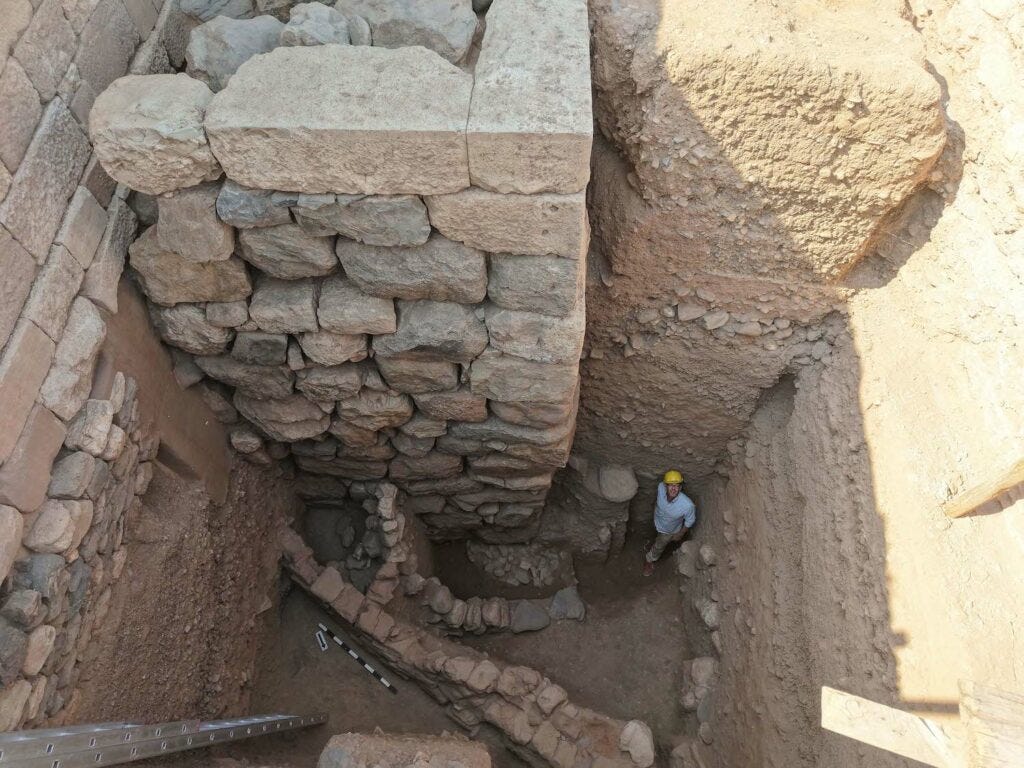Hello all — and welcome to issue #164 of Ancient Beat! Let’s get right into it.
Here’s the latest ancient news. 👇
🗞 Ancient News: Top 5
Cow’s Tooth Strengthens Links Between Stonehenge and Southwest Wales — A Neolithic cow’s molar, buried near Stonehenge’s southern entrance, dates to around 2995–2900 BCE, aligning with the monument’s early construction phase. Isotopic analysis shows the animal likely came from southwest Wales—the same region where Stonehenge’s bluestones were quarried—indicating the transport of livestock over roughly 125 miles (200 km). The tooth also reflects seasonal dietary variations, suggesting the cow grazed across multiple landscapes or was fed non-local fodder. The jaw’s deliberate burial hints at ritual or symbolic significance, strengthening theories that cattle were integral to both the physical movement of stones and ceremonial practices. This discovery provides the first direct animal-based evidence connecting Stonehenge’s builders to southwest Wales.
Ancient Fossil Discovery in Ethiopia Rewrites Human Origins — In northeastern Ethiopia, teeth dating between approximately 2.6 and 2.8 million years ago reveal that early Homo specimens and a newly identified species of Australopithecus coexisted in the same region. Thirteen fossilized teeth show that rather than evolving in a straight line, our early human relatives existed as branches on a complex evolutionary tree. These findings challenge linear views of human evolution—suggesting that our genus and other hominin species shared landscapes and possibly resources, complicating the story of our origins.
2,800‑Year‑Old Lydian Palace Unearthed In Turkey — A monumental Lydian palace dating to the 8th, possibly 9th, century BCE was discovered beneath later Persian, Hellenistic, Roman, and Byzantine layers in Sardis, western Turkey. Buried about 25 ft deep, the structure features massive stone walls measuring 5–8 ft thick and up to 20 ft high. Artifacts recovered from a destruction layer linked to the Persian conquest of 547 BCE include 30 bronze arrowheads, fragments of human remains, and nine silver coins—among the world’s earliest standardized coinage. The discovery pushes back Sardis’s urban development by at least a century, revealing that Lydia had centralized political authority and monumental architecture well before the 7th century BCE, overturning long-held assumptions about the region’s early history.
Archaeologists In Georgia Unearth 1.8‑Million‑Year‑Old Human Jawbone — At Orozmani, about 62 miles southwest of Tbilisi, a lower human jaw dating to roughly 1.8 million years ago was uncovered, likely belonging to Homo erectus. This makes it one of the oldest human fossils outside Africa, highlighting the region’s importance in early human dispersal. Excavations revealed a rich assemblage of animal fossils—including saber‑toothed tigers, elephants, wolves, deer, and giraffes—alongside stone tools, suggesting a thriving ecosystem inhabited by some of Eurasia’s earliest humans. The discovery builds on earlier finds nearby, including a 1.8‑million‑year‑old skull and a tooth, confirming Orozmani as a critical site for understanding early migration patterns, subsistence strategies, and adaptation during the Lower Pleistocene.
Denisovan Genes Gave Early Americans a Survival Edge — A newly analyzed MUC19 gene variant, inherited from Denisovans, appears to have given early populations migrating into the Americas thousands of years ago a crucial adaptive advantage. Found at unusually high frequencies among individuals with Indigenous American ancestry, both in ancient DNA from archaeological sites in Alaska, California, Mexico, and South America and in modern populations today, the gene is linked to producing mucins—protective proteins that form barriers in saliva and mucosal tissues. Its prevalence suggests it underwent strong natural selection, likely improving immune defenses against unfamiliar pathogens encountered in new environments. Genetic evidence also indicates the variant may have first passed from Denisovans to Neanderthals before entering the modern human lineage, underscoring complex interbreeding events. This discovery reveals how ancient genetic exchanges shaped human adaptation and contributed to long-term survival strategies that remain relevant today.
That’s it for the free Top 5! If you’re a free subscriber, sign up for the paid plan for another 28 discoveries and 3 recommended pieces of content covering early farming, hoards, dams, and long-distance trade.
Until next time, thanks for joining me!
-James
Twitter: @jamesofthedrum
P.S. Here’s my Buy Me A Coffee link if you’d like to support my efforts with a donation.
P.P.S. If you want access to the paid version but it’s a little too steep for you right now, just email me — I want this to be accessible.
P.P.P.S. Paid members, read on!
🗞 Ancient News: Deep Dive
Keep reading with a 7-day free trial
Subscribe to Ancient Beat to keep reading this post and get 7 days of free access to the full post archives.


